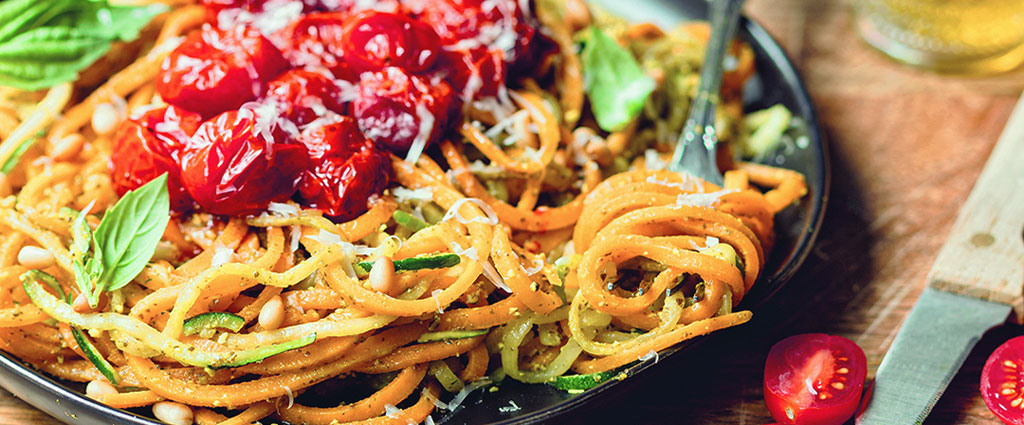Cooking with Tomatoes: Benefits and How-To
While many think of this member of the nightshade family as a vegetable, it’s really a fruit.
Cooking with Tomatoes: Benefits and How-To
While many think of this member of the nightshade family as a vegetable, it’s really a fruit.
What are they?
The tomato (solanum lycopersicum) is a fruit (not a vegetable!) from the nightshade family. Today's tomatoes began as wild plants in the Andes, growing in parts of Bolivia, Chile, Colombia, Ecuador and Peru. Tomatoes are warm-season annuals that grow best when the soil temperature is at least 55°F (12°C) and the air temperature ranges between 65° and 90°F (18-32°C). Tomatoes are commonly grown from seedling starting indoors as early as 6 to 8 weeks before the average date of the last spring frost. Seedlings are usually transplanted into the garden 1 to 3 weeks after the last frost. Early-season tomatoes require 50 to 60 days to reach harvest from transplanting; mid-season require 60 to 80 days; late-season require 80 or more days.
RECIPES USING TOMATOES
What are their potential health benefits?
Tomatoes are the major dietary source of the antioxidant lycopene, which gives them their bright red color and helps protect them from the ultraviolet rays of the sun. In much the same way, tomatoes can help protect your cells from damage.
Consumption of tomatoes and tomato products has been linked to (1,2):
- Eye health: Reduce age-related macular degeneration and protect eyes from digital device blue light. (3)
- Oral health: Help fight gum diseases gingivitis and periodontitis. (3)
- Skin health: May protect against sunburn. (3,4,5)
- Lowered risk of heart disease, including heart attacks and strokes. (6,7)
- Fewer incidences of certain cancers, such as prostate, lung and stomach. (3,8,9)
Three Quick Tips to Help with Iron Deficiency
Need Help with Iron Deficiency? Eat tomatoes!
How do you cook with them?
Tomatoes can be sliced and eaten on their own and added to sandwiches or salads. Tomatoes can be broiled, roasted, stewed, sauteed, fried and cooked in with other dishes. Cooked tomatoes can be eaten as a side dish or appetizer, added to sauces, soups, stews and other savory dishes.
A few tips and tricks:
- Slicing tomatoes works best with a serrated knife.
- Do not use aluminum products when cooking tomatoes to avoid unpleasant taste.
- Add grated carrots to cooked tomatoes instead of sugar to combat acidity.
- The high acid content of the tomato slows the cooking process of some other foods.
What are they?
The tomato (solanum lycopersicum) is a fruit (not a vegetable!) from the nightshade family. Today's tomatoes began as wild plants in the Andes, growing in parts of Bolivia, Chile, Colombia, Ecuador and Peru. Tomatoes are warm-season annuals that grow best when the soil temperature is at least 55°F (12°C) and the air temperature ranges between 65° and 90°F (18-32°C). Tomatoes are commonly grown from seedling starting indoors as early as 6 to 8 weeks before the average date of the last spring frost. Seedlings are usually transplanted into the garden 1 to 3 weeks after the last frost. Early-season tomatoes require 50 to 60 days to reach harvest from transplanting; mid-season require 60 to 80 days; late-season require 80 or more days.
RECIPES USING TOMATOES
What are their potential health benefits?
Tomatoes are the major dietary source of the antioxidant lycopene, which gives them their bright red color and helps protect them from the ultraviolet rays of the sun. In much the same way, tomatoes can help protect your cells from damage.
Consumption of tomatoes and tomato products has been linked to (1,2):
- Eye health: Reduce age-related macular degeneration and protect eyes from digital device blue light. (3)
- Oral health: Help fight gum diseases gingivitis and periodontitis. (3)
- Skin health: May protect against sunburn. (3,4,5)
- Lowered risk of heart disease, including heart attacks and strokes. (6,7)
- Fewer incidences of certain cancers, such as prostate, lung and stomach. (3,8,9)
Three Quick Tips to Help with Iron Deficiency
Need Help with Iron Deficiency? Eat tomatoes!
How do you cook with them?
Tomatoes can be sliced and eaten on their own and added to sandwiches or salads. Tomatoes can be broiled, roasted, stewed, sauteed, fried and cooked in with other dishes. Cooked tomatoes can be eaten as a side dish or appetizer, added to sauces, soups, stews and other savory dishes.
A few tips and tricks:
- Slicing tomatoes works best with a serrated knife.
- Do not use aluminum products when cooking tomatoes to avoid unpleasant taste.
- Add grated carrots to cooked tomatoes instead of sugar to combat acidity.
- The high acid content of the tomato slows the cooking process of some other foods.
ABOUT THE AUTHOR
Stephanie Skinner-Lucas (MS, RDN, LDN) is a prevention and intervention dietitian who mentors each patient, wherever they are in their healthy lifestyle journey, to help them get across the finish line. Stephanie calls herself a "salad junkie," creating balanced, nutritious meals by adding protein, vibrant fruits, vegetables, unusual flavors and exciting textures. In her spare time, she enjoys participating in charity events, improving golf and tennis games, and traveling to the beach.
Did you know? You can meet virtually with a Kroger dietitian to help you achieve your personal wellness nutrition goals. Learn more about Telenutrition.
ABOUT THE AUTHOR
Stephanie Skinner-Lucas (MS, RDN, LDN) is a prevention and intervention dietitian who mentors each patient, wherever they are in their healthy lifestyle journey, to help them get across the finish line. Stephanie calls herself a "salad junkie," creating balanced, nutritious meals by adding protein, vibrant fruits, vegetables, unusual flavors and exciting textures. In her spare time, she enjoys participating in charity events, improving golf and tennis games, and traveling to the beach.
Did you know? You can meet virtually with a Kroger dietitian to help you achieve your personal wellness nutrition goals. Learn more about Telenutrition.
Sources:
1. https://pubmed.ncbi.nlm.nih.gov/17011475/, 2. https://pubmed.ncbi.nlm.nih.gov/9529899/, 3. https://www.webmd.com/food-recipes/ss/slideshow-tomato-health-benefits, 4. https://pubmed.ncbi.nlm.nih.gov/16465309/, 5. https://pubmed.ncbi.nlm.nih.gov/15830922/, 6. https://pubmed.ncbi.nlm.nih.gov/22158914/, 7. https://pubmed.ncbi.nlm.nih.gov/23045517/, 8. https://pubmed.ncbi.nlm.nih.gov/10050865/, 9. https://pubmed.ncbi.nlm.nih.gov/12424325/







Share this Post